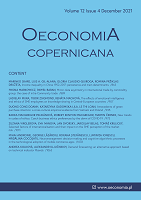Competitiveness, fiscal policy and corruption: evidence from Central and Eastern European countries
Competitiveness, fiscal policy and corruption: evidence from Central and Eastern European countries
Author(s): Ramona Ţigănaşu, Gabriela Carmen Pascariu, Dan LupuSubject(s): Fiscal Politics / Budgeting, Corruption - Transparency - Anti-Corruption
Published by: Instytut Badań Gospodarczych
Keywords: competitiveness; fiscal policy; corruption; competitiveness; fiscal policy; corruption; CEE countries;
Summary/Abstract: Research background: The transformations induced by global challenges call for new approaches towards competitiveness and thus require a consistent rethinking of strategies and mechanisms so that they could be better adapted to the constantly changing context. Prior to the European Union (EU) accession, the Central and Eastern European (CEE) states began a broad process of economic reforms, including trade liberalization, mass privatization, exchange rate liberalization, all of which led to a wider opening to new markets, the creation of new opportunities for production and to ensuring the competitiveness of companies on foreign markets. By far, the most important step in the post-communist period was joining the EU, achieved after 2004. Over time, these states have faced, on the one hand, issues related to addressing systemic vulnerabilities, and on the other hand, finding the most appropriate measures to induce competitiveness. The influence of public policies on competitiveness is still an issue that needs to be debated, our study proposing to examine the reaction of external competitiveness to the increase of government spending and corruption. Purpose of the article: The aim of this paper is to analyze the impact of fiscal policies and corruption on the external competitiveness of the eleven countries from Eastern Europe (Bulgaria, Croatia, Czechia, Estonia, Hungary, Latvia, Lithuania, Poland, Romania, Slovakia and Slovenia) for the period 1995?2020. The choice of this time interval is to better capture the trinomial relationship between competitiveness, fiscal policy and corruption before and after the process of integration of the CEE states into the EU. Methods: The methodology chosen is based on ARDL (Autoregressive Distributed Lag) with structural breaks, the period taken into account being 1995?2020. The Unit root test of augmented Dickey?Fuller ADF (2016) was used to assess the time series stationarity. The test developed by Bai and Perron (2003) is applied to detect structural breaks, by resorting to the LM test. The tests for the cointegration between the considered variables, using the ARDL model, proposed by Pesaran et al. (2001), were also part of the research. The causality test of Granger et al. (2000) was used to assess the conditionality between the indicators. By applying these methods, it was highlighted that, especially after 2007, in the states under analysis, expansionary fiscal policies have led to internal devaluations of the currency, which ultimately increased external competitiveness, measured as real effective exchange rate. Instead, corruption has a negative impact on competitiveness. Findings & value added: The obtained results point out the relationship between competitiveness, fiscal policy and corruption in CEE countries. In the case of those that have a high competitiveness, even if there are large government expenditures, there is also an economic environment conducive to the implementation of measures that generate added value on a large scale. Conversely, in countries where corruption is high, the impact of government fiscal policies on competitiveness is reduced due to the negative effects caused by this phenomenon. Our study brings at least two contributions to the literature. First of all, the research shows how a growth in public spending affects the competitiveness of CEE economies through the real exchange rate. Secondly, it takes into account the phenomenon of corruption applied to Eastern countries, emphasizing a decrease in the external competitiveness of these economies in response to the manifestation of corruption.
Journal: Oeconomia Copernicana
- Issue Year: 13/2022
- Issue No: 3
- Page Range: 667-698
- Page Count: 32
- Language: English

